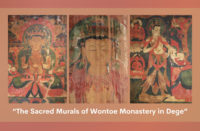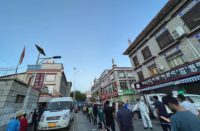
High Peaks Pure Earth has been monitoring online responses to the coronavirus. Tibetans are responding with satire and poetry, as well as disseminating practical information and translating health advisory notices into Tibetan. In addition to producing translations of health warnings and sharing preventative advice, the pandemic is generating a debate about the efficacy of Tibetan medicine.
Ever since news of the coronavirus first broke from Wuhan last month, Tibetans have anxiously followed the spread to their doorsteps with several cases now reported in Amdo (Xining, Kanlho, Ngaba), Kham (Kardze) and U-Tsang (Lhasa).
For a short period, the Tibet Autonomous Region was the only area without the virus but the single case now is a tourist from Wuhan who arrived in Lhasa by train on January 24. Over one thousand unaffected students have returned to their schools in Lhasa, while many of the Chinese doctors who work in Tibet have left the Tibet Autonomous Region to celebrate the Lunar New Year in their hometowns and have not yet returned. The numbers of cases in Kham and Amdo are hard to gauge as the numbers are only available at the provincial level, although some prefectures and counties have released information.
As much of the health warnings and advisories are only available in Chinese, netizens actively took to social media to translate and share information in Tibetan, such as the animated video above released on January 28, 2020, by the “Tibet Information Technology Company”. The video was subsequently translated into four further regional languages.
Qinghai Nationalities Publishing House also published a speedy Tibetan translation of “How the Public Should Protect Themselves Against Coronavirus” on February 1, 2020. In the photo gallery below are examples of Tibetan language coronavirus related graphics and infographics being widely shared on social media.
In addition to heath advice, Tibetans have shared posts related to Tibetan medicine. Below, William A. McGrath introduces a post by renowned scholar Dr. Thubten Phuntsok, an expert of traditional medicine, and shares his translation. Thank you very much to William A. McGrath for this timely contribution.
Introduction to Dr Thubten Phuntsok’s Posts By William A. McGrath

Yuthok Yönten Gönpo wears a mask. The Hippocrates of Tibet, the Tibetan sage who graces the halls of the Mentsikhang, whose very name is synonymous with Tibetan medicine, even he wears a mask. With gentle eyes and colorful robes, surrounded by bodhisattvas and precious offerings, Yuthok holds a myrobalan plant in his right hand and a vase of ambrosia in his left. The mask was a recent addition to the twentieth-century painting, of course, a contribution made by the Weibo user, the “Last Classical Man” (最后的古典人). For several weeks now, masks have been on the faces and minds of people around the world. In these dark times, social media have spread news of mask production numbers, mask shortages, mask mistakes, international and domestic mask aid, and even an unsettling video of a shopkeeper gouging and physically attacking a consumer, all over masks. Why is there such mask hysteria?
Chinese- and Tibetan-language Public Service Announcements have highlighted masks as a tangible object that will protect us from the dangers of the coronavirus. Dr. Thubten Phuntsok, physician of Tibetan medicine and professor emeritus of Tibetan Studies at the Southwest Minzu University in Chengdu, has warned in a recent blog post:
- Do not go out into highly populated places.
- When you do go out, you must make sure to wear a mask.
- When you return home, do not forget to wash your hands.
- Avoid foods from areas that have the contagious disease.
- It would also be helpful to avoid drinking and eating out at restaurants.
Thubten Phuntsok first posted this advice in Tibetan and Chinese on January 24, 2020. It was a more hopeful time, when the coronavirus was largely the problem of Hubei and adjacent provinces. As of January 30, less than one week later, cases were reported in all provinces of China, including the Tibetan areas of Ütsang (Lhasa), Amdo (Xining), and Kham (Kardzé). As the disease has spread, so have debates over the efficacy of various treatments, including mantra recitation and traditional Tibetan medicine. At the end of the post cited above, Thubten Phuntsok asserts that “the efficacy of [traditional] Chinese and Tibetan medicine and religion has not been established,” and that, without the aforementioned measures, “one’s own devotion, faith, mantra recitations, and medicinal amulets will have no effect at all.” Predictably, Dr. Thubten Phuntsok’s comments have been met with both praise and scorn.

In places devoid of contagious disease, the Black-9 Pill is being sold.
The wallets of the Tibetan people empty, while physicians grow rich.
If the disease does arrive, go to the western hospital.
Tibetan medicine has no cure for this new virus.
On January 26, 2020, Dr. Thubten Phuntsok posted a cartoon. Again, despite concerns over flippant visitors from Wuhan, the virus had not yet reached Lhasa at that point. Regardless, however, major monasteries and tourist sites began to close to the public, and a sense of dread had reached even beyond the borders of China. Like the shop owners overcharging for masks and taking advantage of desperate customers, here Gen-la derides unscrupulous physicians who sell questionable medicines for inflated prices. He reiterates his previous point about Tibetan medicine’s lack of efficacy in the face of the coronavirus, and urges Tibetan patients to go to a biomedical hospital to help contain the spread of the disease.
Two days later, Dr. Thubten Phuntsok expanded the spirit of this cartoon into a longer poem that I have translated for you below. He unequivocally addresses those “well-meaning physicians” who, during these desperate times, make a profit by dispensing the Black-9 Pill (nag po dgu sbyor). The Black-9 Pill has a long history in Tibet, and fifteenth-century accounts highlight its efficacy in times of contagious disease, as well as the central ingredient of musk. Musk, which is harvested from the glands of the increasingly rare musk deer, is a precious ingredient that is absent from all but the most expensive medicinal pills these days. Rather than pedal overpriced pills, Dr. Thubten Phuntsok urges, physicians should cultivate generosity and donate their services for free, proving to all that they truly mean well.
* * *

If You Have Honor, Do Not Exploit This Opportunity to Sell Medicine
By Thubten Phuntsok
Translation by William A. McGrath*
Tibetan medicine does not affect
Contagious diseases, neither new nor old. This is indisputable.
In these desperate times,
In order to protect the lives of our nation,
Well-meaning physicians
Have dispensed this Black-9 Pill, a medicine for nyen spirits,
To all Tibetan people.
To raise the price of the Black-9 Pill,
This cheap, convenient medicine,
By a factor of nine, however, is not so well-meaning.
If you have honor, dispense your medicines.
If you have compassion, donate your medicines.
To exploit this opportunity,
And sell your medicine, however, is an act of evil.
Both a beautiful face and money
Are of great value on this earth.
To distort cause and effect
In the pursuit of money, however, is an act of deception.
These days, does the Black-9 Pill
Even contain musk? You know the truth.
If there were even just a little musk
In a Black-9 Pill, wouldn’t the price tag
Be three hundred reminbi? You know the truth.
Thus, Tibetan physicians,
Take advantage of this opportunity for spiritual practice;
Donate medicines throughout the Tibetan lands;
And your good motivation will be praised by all.
Thubten Phuntsok, the vagabond physician from Pelpung in the east, appeals to the physicians of Tibet who sell their medicines while the dangerous and contagious disease, the coronavirus, is on the Central Plain of China. Sent on January 28, from the shores of Pasikuda of the great nation of Sri Lanka.
*William A. McGrath is a Visiting Assistant Professor of Religious Studies at Manhattan College, where he teaches courses on Buddhism and other Asian religions. His research agenda primarily concerns the historical intersections of religious and medical traditions in Tibet and China, and he recently published an edited volume entitled Knowledge and Context in Tibetan Medicine (Brill 2019). Some of his published articles and translations can be found on academia.edu.










Pingback: CORONA VIRUS: RESCUE REMEDIES CHINESE AND TIBETAN | Rukor